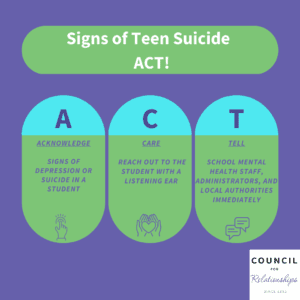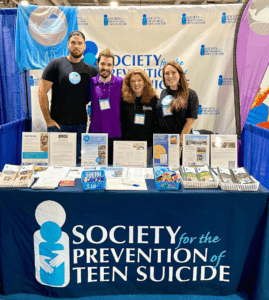Tips for Schools to Support Suicidal Teens in 2023
Suicide is a topic no one wants to consider, and many people feel immensely uncomfortable talking about it. The reality is that suicidal thoughts are common, especially among teens and young adults. Knowing that suicide and suicidal thoughts are common among this age group, and likely underreported due to stigma, what can schools do to keep students safe? The following are five tips for schools to support suicidal teens.
 1 in 5 teens report thoughts of suicide
1 in 5 teens report thoughts of suicide
According to the National Alliance on Mental Illness (NAMI), nearly 20% of teens report having serious thoughts about suicide, and 9% report a suicide attempt. The CDC reports that suicide is the second leading cause of death in youth ages 10-14. Suicide attempts were reported most frequently among girls compared to boys and non-Hispanic Native American/Alaska Native students compared to other groups. LGBTQ+ teens are also at a higher risk of suicide when compared to cisgender and heterosexual teens.

First developed by MindWise Innovations, ACT is a simple way for people to remember how to respond when someone opens up to you about suicidal thoughts.
1. Create Safe Spaces
A common myth about suicidal ideation is that the more we talk about it, the more likely a person is to commit suicide. The truth is, talking about suicide and suicidal ideation destigmatizes these thoughts and allows for a safe space for students to process the difficult emotions that come with thoughts of suicide.
Train school staff to recognize the signs of suicide, which include significant changes in behavior or mood, hopelessness or feeling overwhelmed, and/or talking, writing, or posting about wanting to die or kill themselves. It is important to acknowledge and validate the student’s feelings and help them understand the meaning behind these feelings.
The Signs of Suicide Program recommends that school staff learn how to ACT:
Acknowledge: signs of depression or suicide in a student
Care: Reach out to the student with a listening ear
Tell: School mental health staff, administrators, and/or local authorities immediately
It is also important to educate students about suicide, and what to do if they are having suicidal thoughts. There are various curriculums and training modules available for schools to utilize including Signs of Suicide and Lifelines Intervention.
A school-wide assembly to discuss suicide is never recommended.
Small group settings with exit tickets help provide a more comfortable environment for students to understand suicide and request help for themselves or a friend.

Peggy Rajski (pictured here) and Randy Stone founded The Trevor Project, the first national crisis intervention and suicide prevention lifeline for LGBTQ+ youth, in 1998.
2. Create a Crisis Team
Teachers are already stretched so thin with all of their responsibilities during the school day. They’re managing the ever-changing behavioral and educational needs of their students while also balancing state mandates for standardized testing and curriculum.
That being said, the teacher is frequently the first person who notices changes in students. Schools need to establish a Crisis Team for teachers to refer any high-risk students. School social workers, guidance counselors, school psychologists, and Student Assistance Counselors (SAC) are already trained in matters of mental health and are key staff to recruit for a Crisis Team in addition to administrators. These are members that can be called in to assess students, provide mental health support, provide resources, and make referrals.

Dr. Kelly Posner Gerstenhaber, Founder and Director of the Columbia Lighthouse Project.
3. Utilize suicide screening assessments
The Columbia Suicide Severity Rating Scale (CSSRS) was created to help any first responder in assessing a person for suicidal ideation including the severity and intensity of suicidal thoughts as well as behaviors that may indicate risk of suicide. This is an accessible assessment for a school because it can be used by any staff member, not just mental health providers.
The information on the CSSRS can help your school’s staff determine whether a student is at high risk for attempting suicide or even if a student is engaging in self-injury. This is a widely used assessment and provides valuable data for making referrals to other providers. The Columbia Lighthouse Project provides free training modules for staff to learn how to use the CCSRS.

Phil and Donna Satow founded The Jed Foundation after losing their son to suicide.
4. Come up with a safety plan
Once a student has been identified as being at high risk for suicide, it is critical to come up with a safety plan. The following are important questions to ask when creating a safety plan:
- Does the student have access to lethal means at home including weapons or controlled substances?
- What support will the student be getting outside of school? How are the student’s parents or guardians involved with the safety plan?
- Is the student safe to leave the school building or must they be picked up by a parent/guardian or ambulance to be further screened?
- Can the student identify protective factors like reasons to live, ability to use coping skills, or intent to follow through with additional help?
- What support can the school offer during the day to help the student cope? This may include check-ins with their guidance counselor/crisis team member, connecting the student with a mentor, or assisting the student in joining other school activities.

The Society for the Prevention of Teen Suicide was founded in 2005 to increase awareness, save lives, and reduce the stigma of suicide.
5. Make a referral
While schools are in a great position to identify mental health issues, schools should not be the primary place where students get mental health support. Depending on the severity of the suicidal ideation, a student can be referred to different mental health supports in the community. Connecting students with therapists for talk therapy, and/or psychiatrists for medication management are usually the first level of support when a student expresses depression.
The next level of support would be a referral to a partial hospitalization program or intensive outpatient program. These are day programs ranging from 3-5 days a week for approximately 6-8 weeks where the student would receive support from therapists and psychiatrists in a group therapy setting.
The highest level of support would be inpatient treatment, where the student would remain in a locked unit under 24-hour supervision for approximately 3-10 days. The student would receive individual and group therapy as well as medication management.
If a student is identifying an intent to harm themselves or a suicide plan, referral to the closest crisis screening center or emergency room is crucial. When working with adolescents and teens, it is essential to know which screening centers in your area will service this age group. Calling ahead before the student is transported to the screening center, via ambulance or parent/guardian, is recommended.
Teen Suicide is Preventable
Though suicide prevention in schools may seem like a daunting task, it is a crucial component of providing support to adolescents and teens who are struggling. Suicide is preventable, and help is available. In addition to these five tips for schools to support suicidal teens, check out the following resources:
For additional information or support around suicide prevention, contact your state department.
If you are anyone you know is struggling with suicidal thoughts, contact the 988 Suicide and Crisis Lifeline by calling or texting 988.

CFR Staff Therapist Danielle Silverman, LCSW, MEd
About the Author
Danielle Silverman, LCSW, MEd, is a Staff Therapist at Council for Relationships. If you have questions about Danielle’s tips for schools to support suicidal teens or if you would like to schedule an appointment with her, you may reach her at dsilverman@councilforrelationships.org or 215-382-6680 ext. 7015.
If you are looking for individual, couple, or family therapy or psychiatry, click here to request an appointment. See our Therapist & Psychiatrist Directory to find additional CFR therapists or psychiatrists near you.
